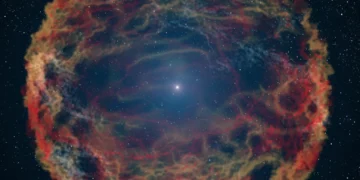The universe is full of explosive and high-energy events, but few are as awe-inspiring—or potentially dangerous—as supernovae and gamma-ray bursts (GRBs). These cosmic phenomena release immense amounts of energy, enough to outshine entire galaxies for brief periods. While we often think of them as distant celestial fireworks, could they pose a threat to Earth? And more importantly, would we even see them coming?
The Explosive Power of a Supernova
A supernova occurs when a massive star runs out of nuclear fuel and collapses under its own gravity, leading to a spectacular explosion. This can happen in two primary ways:
- Core-collapse supernova – When a massive star (at least 8 times the mass of the Sun) exhausts its fuel, collapses, and explodes.
- Type Ia supernova – When a white dwarf in a binary system accumulates too much material from its companion star and detonates in a thermonuclear explosion.
Both types of supernovae release vast amounts of energy, producing gamma rays, X-rays, and cosmic rays that travel through space. If one occurred close enough to Earth, it could affect our atmosphere and biosphere in profound ways.
How Dangerous is a Nearby Supernova?
A supernova occurring within 30 light-years of Earth could have severe consequences. The primary dangers come from:
- X-ray and gamma-ray radiation – These can strip away the ozone layer, leaving Earth exposed to harmful ultraviolet (UV) radiation from the Sun.
- Cosmic rays – High-energy particles ejected from the explosion could continue arriving at Earth for hundreds or even thousands of years, potentially damaging the atmosphere and increasing the risk of genetic mutations and cancer.
Thankfully, astronomers have mapped out nearby stars and found no imminent threats within this danger zone. The closest known supernova candidate, Betelgeuse, is about 650 light-years away, far enough that its explosion would be a spectacular sight—but not a hazard.
The Hidden Dangers of Dust-Obscured Supernovae
Not all supernovae are easy to detect before they explode. Some are shrouded in thick clouds of dust, making them difficult to observe until the explosion occurs.
When the shockwave from such a supernova collides with surrounding dust, it produces an intense burst of X-rays—far more than a typical supernova. This could have devastating consequences if aimed toward Earth.
Even more concerning is that after the initial radiation surge, cosmic rays from the explosion would continue to bombard Earth for centuries, gradually degrading the atmosphere and affecting life.
Scientists have carefully scanned the skies for hidden supernova candidates within dangerous proximity and have not found any immediate threats. However, the possibility of an undetected supernova lurking behind a dust cloud cannot be completely ruled out.
Type Ia Supernovae: The Unpredictable Cosmic Bombs
Unlike core-collapse supernovae, Type Ia supernovae are much harder to predict. These occur when a white dwarf in a binary system accumulates enough mass from a companion star until it reaches a critical threshold, triggering a sudden thermonuclear explosion.
The problem? White dwarfs are small, dim, and difficult to track, meaning we may not see it coming until it explodes.
The closest known Type Ia supernova candidate is IK Pegasi, located 150 light-years away. While outside the immediate danger zone, it serves as a reminder that there are many more white dwarfs out there we may not have identified yet.
Gamma-Ray Bursts: The Most Lethal Cosmic Phenomenon
Supernovae are powerful, but gamma-ray bursts (GRBs) take cosmic destruction to another level. GRBs are the most energetic explosions in the universe, releasing in seconds what the Sun will emit over its entire lifetime.
These bursts come from two sources:
- Neutron star mergers – When two neutron stars collide, they release an intense flash of gamma rays.
- Hypernovas – When an ultra-massive star collapses into a black hole, its explosion launches a powerful, focused beam of gamma radiation into space.
The danger of a GRB comes from its narrow, concentrated beam. While most bursts miss Earth, if one were aimed directly at us, the consequences could be catastrophic.
How Bad Would a Gamma-Ray Burst Be for Earth?
A gamma-ray burst as far as 10,000 light-years away could still pose a major threat. If Earth were directly in its path, the effects would include:
- Severe ozone depletion, allowing extreme UV radiation from the Sun to reach Earth’s surface.
- Mass extinction events due to radiation exposure and disruption of ecosystems.
- Long-term climate changes caused by atmospheric disturbances.
Some scientists believe that a past gamma-ray burst may have contributed to a mass extinction event on Earth millions of years ago.
The good news? There are no known GRB-producing stars close enough to Earth to pose an immediate threat. However, because GRBs are unpredictable, they remain one of the biggest cosmic wildcards in astronomy.
Would We See It Coming?
For most supernovae, astronomers would detect warning signs before the explosion occurs. A star about to go supernova swells in size, becomes unstable, and exhibits irregular brightness patterns, giving us months or years of advance notice.
However, for dust-obscured supernovae and Type Ia explosions, we might have little to no warning.
For gamma-ray bursts, we wouldn’t see it coming at all. Because they travel at the speed of light, the first indication of a GRB aimed at Earth would be the moment it hits.
Should We Be Worried?
While the potential dangers of supernovae and gamma-ray bursts are real, the actual risk is extremely low. Astronomers have spent decades mapping nearby stars and have found no immediate threats within dangerous proximity.
That said, the unpredictability of Type Ia supernovae and GRBs means the possibility is never zero. Continued research and advancements in space observation technology are essential to keep monitoring the skies for new potential threats.
Conclusion: The Universe is a Safe but Unpredictable Place
The cosmos is filled with wonders and hazards, and while supernovae and gamma-ray bursts are among the most violent events in existence, Earth remains well-protected.
Reference:
Earth’s atmosphere protects the biosphere from nearby supernovae



















